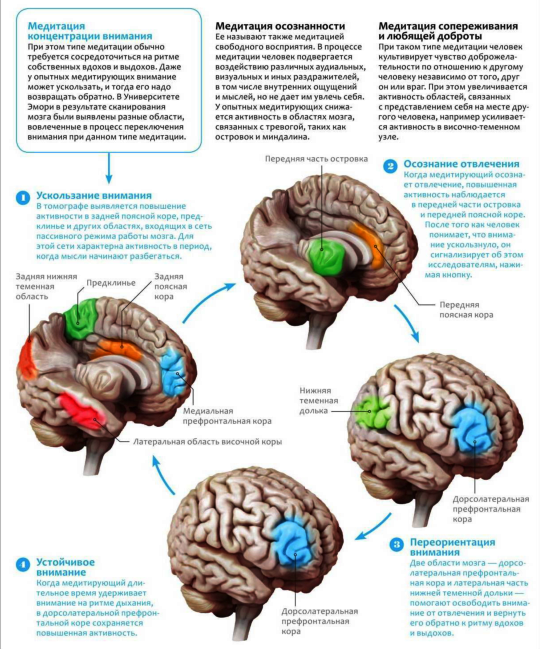694
Neurobiology of meditation
Seventy seven million four hundred eighty one thousand three hundred seventy eight
When in 2005 the Neurobiological society called Tenzin Gyatso (14th Dalai Lama) at its annual meeting in Washington, among the 35 thousand attendees, several hundred people demanded to cancel the invitation. They believed that the scientific meeting is no place for religious leaders. But it turned out that he was asking the audience a provocative and useful question. Tenzin Gyatso said, "how can there be a connection between Buddhism, an ancient Indian religious-philosophical traditions and modern science?"
Before you start the conversation, the Dalai Lama has managed to do something to find the answer to this question. In the 1980s he initiated the discussion of prospects of cooperation of science and Buddhism that led to the creation of "Mind and life", aimed at studying the meditative Sciences. In 2000, he set a new project goal, organize the direction of "Meditative neuroscience", and invited scientists to study the brain activity of the Buddhists, are seriously involved with meditation and having more than 10 thousand hours of practice.
Over the past 15 years, more than 100 Buddhists, monks and laymen, and also a large number of people recently begun to practice meditation, took part in scientific experiments at the University of Wisconsin in Madison and 19 other universities. The article you are reading is the result of collaboration between two neuroscientists and a Buddhist monk, originally trained as a biologist.
Comparing the pattern of brain activity in people meditirovaniya in your life tens of thousands of hours, and those who engaged in this recently, we began to understand why such methods of consciousness training can give large cognitive and emotional benefits. The goals of meditation overlap with many tasks of clinical psychology, psychiatry, preventive medicine and education. An increasing number of studies have shown in favor of the fact that meditation can be effective in the treatment of depression, chronic pain and generate an overall feeling of well-being.
The discovery of the benefits of meditation is consistent with the data, which were obtained recently by neuroscientists that the adult brain retains the ability to significantly change under the influence of experience. It has been shown that the brain changes when we learn to juggle or play a musical instrument, and this phenomenon is called neuroplasticity. With the increasing skill of the violinist increases the area of the brain that controls finger movement. Apparently, similar processes occur during meditation. In the environment nothing will change, but the meditator regulates his mental state, creating an internal experience that affect the operation and structure of the brain. In the result of the performed studies accumulate evidence of positive impact of meditation on the brain, thinking and even the whole body.
Advances in neuroimaging and other technologies have allowed scientists to understand what is happening in the brain during each of the three major forms of Buddhist meditation—concentration, mindfulness and compassion. The diagram below allows you to see the cycle of events occurring during meditation, attention, and activation of corresponding brain areas. (clickable)

What is meditation?
Meditation is found in the spiritual practices of almost all the major religions. The media, referring to meditation, use this word with different meanings. We will talk about meditation as a way to develop basic human qualities such as stability and clarity of mind, emotional balance, and even love and compassion — those qualities that are sleeping while you people will not make efforts for their development. In addition, meditation is the process of exploring a more relaxed and flexible lifestyle.
Meditation is a simple enough exercise, and it can be enjoyed anywhere. This does not require special equipment or uniforms. To begin practice, one must take a comfortable position, not very hard, but not too relaxed, and wish you changes in themselves, well-being and alleviate the suffering of others. Then it is necessary to stabilize the consciousness, which is often disordered and filled with flow of internal noise. To control the consciousness, it is necessary to get rid of automatic mental associations and internal distractions.
Consider what happens in the brain during three common types of meditation that come from Buddhism and are now used outside of religious context, in hospitals and schools around the world. The first type of meditation— the so-called meditation is concentration: the mind in the current time limit and direct, developing the ability not to be distracted. The second type is mindfulness meditation (clear mind) or the free perception, in which man strives to develop a peaceful understanding of one's own emotions, thoughts and feelings, experiencing them in the moment, not to let them get out of control and bring it to a mental disorder. With this type of meditation, the person keeps any attention to their feelings, but not focused on anything in particular. And finally, the third type is known in the Buddhist practice of compassion and charity, and promotes altruistic attitude towards others.
Under the supervision of the instrument
Neuroscientists have only recently begun to study the phenomena occurring in the brain during various types of meditation. Hasenkamp Wendy (Wendy Hasenkamp) of Emory University, along with colleagues used MRI to identify brain areas in which there is increased activity of concentration during meditation. While in the scanner, subjects concentrated on the sensations of breathing. Usually attention starts to slip away, the meditator must recognize this and to regain focus on the rhythm of inhalation and exhalation. In this study, subjects were required use the button to signal the loss of attention. Researchers have determined that there is a cycle of four phases: escaping attention, the moment of awareness of distraction, refocusing attention and a resumption of focused attention.
At each of the four phases involves different brain areas. In the first stage, when a distraction occurs, increases activity areas that form a network of passive mode of operation of the brain. It integrates areas such as the medial prefrontal cortex, posterior cingulate cortex, breakline, lower parietal lobule and the lateral region of the temporal cortex. It is known that these structures are active in a time when we are "head in the clouds." They play a leading role in establishing and maintaining an internal model of the world based on long-term memory about myself and others.

While one of the authors of this article, Matthieu Ricard meditates, his mind active actively recorded using electroencephalogram of the brain.
In the second phase, when is recognized the diversion, activated other brain regions — the anterior portion of the islet and anterior cingulate cortex (structures form a network responsible for cognitive and emotional functions). These areas are associated with subjective feelings that can contribute to distraction during task performance. It is assumed that they play a key role in identifying new events and switching between different networks of neurons during meditation. For example, they can bring the brain from a passive mode of operation.
The third phase involves additional areas, including dorsolateral prefrontal cortex and nesnelerin part of the parietal lobe that return attention to the "uncoupled" from the distracting stimulus.
And finally, on the last, fourth stage there is a high level of activity in dorsolateral prefrontal cortex that allows us to keep the attention of the meditator to a certain goal, for example on the breath.
Further we observed in our laboratory in Wisconsin, the differences in brain activity depending on the experience of the subjects. Paradoxically, but people with serious meditation experience (more than 10 thousand hours), compared to novices were observed less activity in areas associated with the restoration of attention. As you accumulate experience, people learn to hold their attention with less efforts. A similar phenomenon is observed in professional musicians and athletes that perform actions automatically with minimal conscious control.
In addition, to study the effect of meditation is associated with concentration, we studied volunteers before and after three months of intensive training at least eight hours a day. They were given headphones, of which we heard the sound of a certain frequency, and sometimes a little more high-pitched sounds. For ten minutes people had to focus on the sounds and to respond to the higher tone. It turned out that people after a long period of meditation was less difference in the reaction rate from time to time compared to those who are not engaged in meditation. This means that after prolonged exercise in the consciousness of man retains better attention and less distracted. People with experience of meditation electrical activity in response to high-pitched sounds were more stable.
Stream of consciousness
Second, also well-studied form of meditation that involved a different type of attention. In meditation of mindfulness, or a free of perception, the meditator must notice all the looks or sounds and keep track of your feelings and internal dialogue. The person remains aware of what is happening, not focusing on any one feeling or one thought, and returns himself to this distant perception as soon as the mind begins to wander.
As a result of such exercise everyday annoying events — aggressive colleague at work, the annoying child— lose destructive action and is developing a sense of psychological well-being.
Together with Helen, Slagter (Heleen Slagter), who worked with us in Wisconsin, we wanted to understand that. as this kind of training changes the perception.
We evaluated how mindfulness meditation affects the ability to notice rapidly presented visual stimuli. Participants had to notice two numbers that are quickly flashed on the screen among a series of letters. If the second number appeared later, 300 milliseconds after the first, people often did not notice the second. This phenomenon is called flashing attention. If the second number occurs within 600 milliseconds, typically the problems to his notice, does not arise. A blink of the attention arises from the fact that the brain is hard to analyze two stimuli are presented with a small interval. If the first stimulus is directed too much attention, the second is usually overlooked, although during some presentations, the observer sees it.
We hypothesized that meditation classes can reduce the tendency to get "stuck" on the first stimulus. In meditation of mindfulness, people learn to see and not to react, and as a result may decrease the probability of a blink of attention. And indeed, it turned out that after three months of intensive meditation people have noticed both numbers more frequently than the control group. Improved perception was also reflected in the weakening of the brain response to the first number. As a result of observing electrical activity in the brain, namely the amplitude of the P3b component evoked potential, which allows to evaluate the distribution of attention, it became clear that people involved in meditation, can optimize their attention in such a way as to minimize the flashing effect.
The awareness of unpleasant feelings allows you to reduce maladaptive emotional reactions, helps to overcome discomfort and can be particularly useful to combat the pain. In our laboratory, in Wisconsin we studied people with extensive meditation experience, while they were engaged in a complex form of mindfulness meditation called open presence. With such varieties of meditation, which is sometimes called pure perception, consciousness is calm and relaxed or not focused, but it remains alive clarity of mind, without agitation or retardation. The meditator observes without trying to interpret, change, delete, or ignore the soreness. We found that during meditation, the pain intensity is not reduced, but it bothers meditating less than people in the control group.
Compared with novices, people with extensive meditation experience, in the period before the influence was observed less activity in areas of the brain associated with anxiety, the island and the amygdala. With repeated pain exposure in the brain of experienced meditators in areas associated with pain were more addictive than novices. In other tests conducted in our laboratory, it was shown that training of consciousness enhance the ability to monitor and mitigate the main physiological responses, such as inflammation or the release of hormones in stressful social situations such as public speaking or mental math the face of strict Commission.
Several studies have shown that mindfulness meditation has beneficial effects for symptoms of anxiety or depression, and improves sleep. Having the opportunity to consciously observe and monitor your thoughts and emotions, depressed patients can use meditation in alarming situations for the management of spontaneous and Intrusive negative thoughts and feelings. Clinical psychologists John Teasdale (John Teasdalc), who worked at Cambridge University, and Zindel Segal (Zindel Segal) from the University of Toronto in 2000 showed that patients who had previously undergone at least three periods of depression after six months of practice of mindfulness meditation combined with cognitive therapy the risk of relapse during the year reduced by about 40%. Later, Segal has shown that meditation works better than placebo and comparable in effectiveness to standard antidepressant therapy methods.

Compassion and mercy
The third type of meditation develops compassion and mercy towards people. In the beginning the meditator is aware of the needs of the other person, and then experiencing a sincere desire to help or relieve the suffering of others, protecting them from their own destructive behavior.
Went into a state of compassion, the meditator sometimes begins to experience the same feelings as another person. But for the formation of a compassionate state of presence just enough emotional resonance with other's feelings. Must be more unselfish desire to help someone who is suffering. This form of meditation focused on love and empathy, more than just a spiritual exercise. It is shown that it helps to maintain the health of social workers, teachers and other people with the risk of burnout due to feelings that they feel deeply affected by other people's problems.
Meditation begins with the fact that the person focuses on unconditional kindness and love to others and silently repeats to himself the wish, for example: "May all beings find happiness and be free from suffering". In 2008, we studied the brain activity of people engaged in this type of meditation, thousands of hours. We gave them to listen to the voices of suffering and discovered that they have increased activity of some areas of the brain. We know that empathy and other emotional reactions involved the secondary somatosensory cortex and the islet. When listening to the suffering of the votes of experienced meditators compared with control group data structure intensified stronger. This means that they are better shared other people's feelings without experiencing emotional overload. Experienced meditators also observed increased activity in the temporo-parietal node, the medial prefrontal cortex and the anterior temporal sulcus. All these structures usually are activated when we mentally put ourselves in the place of another person.
Recently, Tania singer (Tania Singer) and Olga Klimecki (Olga Klimecki) from the Institute of human cognitive and brain science on Society. Max Planck with one of the authors of this article (Mathieu Ricard) tried to identify the differences between ordinary empathy and compassion from meditators. They showed that compassion and altruistic love are associated with positive emotions, and suggested that emotional exhaustion or burnout is, in fact, exhaustion of empathy.
According to the Buddhist traditions of contemplation, which went from this practice, compassion should not cause fatigue and depression, it strengthens the inner balance, strength of spirit and it gives determination to help the suffering. When a child is hospitalized, the mother would benefit more if you will hold his hand and reassure with gentle words than if overloaded with empathy and concern, unable to endure the sight of a sick child, will rush down the corridor. In the latter case it can result in burnout, which, according to a U.S. research suffered about 60% of the 600 people surveyed, caring for the sick.
For further study of the mechanisms of empathy and compassion Klimecki and singer shared about 60 volunteers into two groups. The first group meditation was associated with love and compassion, in the other group developed a sense of empathy towards others. As shown by the preliminary results, week of meditation-based loving kindness and compassion, led to the fact that the participants, though not previously had experience, had more friendly feelings while watching videos with the affected people. The participants from the other group, which during the week, only trained in empathy, experiencing the same emotions that afflicted people in the video. These emotions caused negative feelings and thoughts, and the participants of this group experienced a lot of stress.
Identifying such devastating consequences, singer and Klimecki conducted with the second group meditation of compassion. It turned out that the extra classes have reduced the negative effects of empathy training: a number of negative emotions decreased and goodwill increased. This was accompanied by corresponding changes in brain regions associated with empathy, positive emotions and maternal love, including the orbitofrontal cortex, ventral striatum and anterior singulyarnoi cortex. In addition, the researchers showed that the practice of compassion during the week increased prosocial behavior in a computer game, specially designed to assess the desire to help others.
Doors of consciousness
Meditation helps to explore the nature of thinking, giving a person the opportunity to explore your consciousness and mental state. In Wisconsin we studied the electrical activity of the brain of the Buddhists, having a great meditation experience, recording the electroencephalogram (EEG) during compassion meditation.
It turned out that experienced Buddhists could arbitrarily support a condition characterized by a certain rhythm of electrical activity in the brain, namely high amplitude gamma oscillations with a frequency 25-42 Hz. This coordination of the electrical activity of the brain can be of great importance for the creation of temporary neural networks of cognitive and emotional functions in the process of learning and conscious perception, which can lead to long-term changes in the brain.
During meditation, high-amplitude oscillations lasted for several tens of seconds, and they were the more was the experience of the meditator. First of all, these features EEG was expressed in the lateral region of the frontal-parietal cortex. They can reflect people raising awareness about the environment and internal thought processes, but to understand the role of the gamma rhythm further research is needed.
Meditation not only causes changes in certain cognitive and emotional processes, but also contributes to the increase in certain parts of the brain. Presumably this is due to the increase in the number of connections between neurons. A preliminary study conducted by Sara Lazar (Lazar Sara) with colleagues from Harvard University, showed that people with more experience of meditation increased gray matter in the insular lobe and in the prefrontal cortex, specifically in the fields 9 and 10 Brodmann that are often activated in various forms of meditation. These differences were most pronounced in elderly study participants. It is assumed that meditation can slow the rate of thinning of brain tissue that occur with age.
In the future work of Lazar and colleagues showed that those subjects in whom the result of the meditation of mindfulness most strongly decreased reaction to stress, and also reduced volume of the amygdala — a brain area involved in the formation of fear. Later, Eileen Luders (Luders Eileen), University of California, Los Angeles, together with colleagues discovered. what meditators differ in the number of axons— fibers that connect different brain regions. It is assumed that this is due to an increase in the number of connections in the brain. This observation argues in favor of the assumption that meditation actually cause structural changes in the brain. An important drawback of these studies is the lack of long-term studies in which people would be observed for many years, and the lack of comparative studies of people of the same age and similar background, which would differ only because they meditate or not.
There are even some evidence that meditation and the ability to use it to improve their own condition can reduce inflammation and other biological responses that occur at the molecular level. As was shown in a study conducted jointly by our group and the group under the leadership of Pearl Kaliman (Perla Kaliman) from the Institute of biomedical research in Barcelona, for experienced meditators only one day of intensive meditation mindfulness, to reduce the activity of genes associated with inflammatory response and affect the proteins that activate these genes. Cliff Capon (Cliff Saron) from the University of California at Davis studied the effect of meditation on a molecule involved in the regulation of lifespan of the cells. This molecule, the enzyme telomerase that lengthens DNA at the ends of chromosomes. The ends of chromosomes, called telomeres, provide safety of the genetic material during cell division. During each division the telomeres shorten, and when their length decreases to a critical value, the cell stops dividing and gradually aging. In comparison with the control group, the meditators more effectively decreased psychological stress and had higher telomerase activity. Sometimes meditation mindfulness can slow down the cell aging processes.
The way to prosperity
Over 15 years of research was able to show that prolonged meditation not only significantly change the structure and functioning of the brain, but also significantly affect the biological processes critical for physical health.
Further studies are needed, using clear evidence from randomized controlled trials to separate the effects caused by meditation, are associated with other psychological factors that can also influence research results. This, for example, the level of motivation of the meditator and the role played by teachers and pupils in the group of meditators. Further research is needed to clarify the possible negative side effect of meditation, the desirable length of the lessons and ways of adapting them to the needs of that individual.
But with all the precautions it is obvious that the studies of meditation, we gained new insights into methods of mental preparation that can potentially improve the health and well-being. Equally important, the ability to cultivate compassion and other positive human qualities lays the Foundation for creating ethical standards, unattached to any philosophy or religion. It can deeply and positively influence all aspects of human society.
Translation: I. S. Bagotsky
published
P. S. And remember, just changing your mind — together we change the world! ©
Source: olmins.info/nejrobiologiya-meditacii/.html
When in 2005 the Neurobiological society called Tenzin Gyatso (14th Dalai Lama) at its annual meeting in Washington, among the 35 thousand attendees, several hundred people demanded to cancel the invitation. They believed that the scientific meeting is no place for religious leaders. But it turned out that he was asking the audience a provocative and useful question. Tenzin Gyatso said, "how can there be a connection between Buddhism, an ancient Indian religious-philosophical traditions and modern science?"
Before you start the conversation, the Dalai Lama has managed to do something to find the answer to this question. In the 1980s he initiated the discussion of prospects of cooperation of science and Buddhism that led to the creation of "Mind and life", aimed at studying the meditative Sciences. In 2000, he set a new project goal, organize the direction of "Meditative neuroscience", and invited scientists to study the brain activity of the Buddhists, are seriously involved with meditation and having more than 10 thousand hours of practice.
Over the past 15 years, more than 100 Buddhists, monks and laymen, and also a large number of people recently begun to practice meditation, took part in scientific experiments at the University of Wisconsin in Madison and 19 other universities. The article you are reading is the result of collaboration between two neuroscientists and a Buddhist monk, originally trained as a biologist.
Comparing the pattern of brain activity in people meditirovaniya in your life tens of thousands of hours, and those who engaged in this recently, we began to understand why such methods of consciousness training can give large cognitive and emotional benefits. The goals of meditation overlap with many tasks of clinical psychology, psychiatry, preventive medicine and education. An increasing number of studies have shown in favor of the fact that meditation can be effective in the treatment of depression, chronic pain and generate an overall feeling of well-being.
The discovery of the benefits of meditation is consistent with the data, which were obtained recently by neuroscientists that the adult brain retains the ability to significantly change under the influence of experience. It has been shown that the brain changes when we learn to juggle or play a musical instrument, and this phenomenon is called neuroplasticity. With the increasing skill of the violinist increases the area of the brain that controls finger movement. Apparently, similar processes occur during meditation. In the environment nothing will change, but the meditator regulates his mental state, creating an internal experience that affect the operation and structure of the brain. In the result of the performed studies accumulate evidence of positive impact of meditation on the brain, thinking and even the whole body.
Advances in neuroimaging and other technologies have allowed scientists to understand what is happening in the brain during each of the three major forms of Buddhist meditation—concentration, mindfulness and compassion. The diagram below allows you to see the cycle of events occurring during meditation, attention, and activation of corresponding brain areas. (clickable)

What is meditation?
Meditation is found in the spiritual practices of almost all the major religions. The media, referring to meditation, use this word with different meanings. We will talk about meditation as a way to develop basic human qualities such as stability and clarity of mind, emotional balance, and even love and compassion — those qualities that are sleeping while you people will not make efforts for their development. In addition, meditation is the process of exploring a more relaxed and flexible lifestyle.
Meditation is a simple enough exercise, and it can be enjoyed anywhere. This does not require special equipment or uniforms. To begin practice, one must take a comfortable position, not very hard, but not too relaxed, and wish you changes in themselves, well-being and alleviate the suffering of others. Then it is necessary to stabilize the consciousness, which is often disordered and filled with flow of internal noise. To control the consciousness, it is necessary to get rid of automatic mental associations and internal distractions.
Consider what happens in the brain during three common types of meditation that come from Buddhism and are now used outside of religious context, in hospitals and schools around the world. The first type of meditation— the so-called meditation is concentration: the mind in the current time limit and direct, developing the ability not to be distracted. The second type is mindfulness meditation (clear mind) or the free perception, in which man strives to develop a peaceful understanding of one's own emotions, thoughts and feelings, experiencing them in the moment, not to let them get out of control and bring it to a mental disorder. With this type of meditation, the person keeps any attention to their feelings, but not focused on anything in particular. And finally, the third type is known in the Buddhist practice of compassion and charity, and promotes altruistic attitude towards others.
Under the supervision of the instrument
Neuroscientists have only recently begun to study the phenomena occurring in the brain during various types of meditation. Hasenkamp Wendy (Wendy Hasenkamp) of Emory University, along with colleagues used MRI to identify brain areas in which there is increased activity of concentration during meditation. While in the scanner, subjects concentrated on the sensations of breathing. Usually attention starts to slip away, the meditator must recognize this and to regain focus on the rhythm of inhalation and exhalation. In this study, subjects were required use the button to signal the loss of attention. Researchers have determined that there is a cycle of four phases: escaping attention, the moment of awareness of distraction, refocusing attention and a resumption of focused attention.
At each of the four phases involves different brain areas. In the first stage, when a distraction occurs, increases activity areas that form a network of passive mode of operation of the brain. It integrates areas such as the medial prefrontal cortex, posterior cingulate cortex, breakline, lower parietal lobule and the lateral region of the temporal cortex. It is known that these structures are active in a time when we are "head in the clouds." They play a leading role in establishing and maintaining an internal model of the world based on long-term memory about myself and others.

While one of the authors of this article, Matthieu Ricard meditates, his mind active actively recorded using electroencephalogram of the brain.
In the second phase, when is recognized the diversion, activated other brain regions — the anterior portion of the islet and anterior cingulate cortex (structures form a network responsible for cognitive and emotional functions). These areas are associated with subjective feelings that can contribute to distraction during task performance. It is assumed that they play a key role in identifying new events and switching between different networks of neurons during meditation. For example, they can bring the brain from a passive mode of operation.
The third phase involves additional areas, including dorsolateral prefrontal cortex and nesnelerin part of the parietal lobe that return attention to the "uncoupled" from the distracting stimulus.
And finally, on the last, fourth stage there is a high level of activity in dorsolateral prefrontal cortex that allows us to keep the attention of the meditator to a certain goal, for example on the breath.
Further we observed in our laboratory in Wisconsin, the differences in brain activity depending on the experience of the subjects. Paradoxically, but people with serious meditation experience (more than 10 thousand hours), compared to novices were observed less activity in areas associated with the restoration of attention. As you accumulate experience, people learn to hold their attention with less efforts. A similar phenomenon is observed in professional musicians and athletes that perform actions automatically with minimal conscious control.
In addition, to study the effect of meditation is associated with concentration, we studied volunteers before and after three months of intensive training at least eight hours a day. They were given headphones, of which we heard the sound of a certain frequency, and sometimes a little more high-pitched sounds. For ten minutes people had to focus on the sounds and to respond to the higher tone. It turned out that people after a long period of meditation was less difference in the reaction rate from time to time compared to those who are not engaged in meditation. This means that after prolonged exercise in the consciousness of man retains better attention and less distracted. People with experience of meditation electrical activity in response to high-pitched sounds were more stable.
Stream of consciousness
Second, also well-studied form of meditation that involved a different type of attention. In meditation of mindfulness, or a free of perception, the meditator must notice all the looks or sounds and keep track of your feelings and internal dialogue. The person remains aware of what is happening, not focusing on any one feeling or one thought, and returns himself to this distant perception as soon as the mind begins to wander.
As a result of such exercise everyday annoying events — aggressive colleague at work, the annoying child— lose destructive action and is developing a sense of psychological well-being.
Together with Helen, Slagter (Heleen Slagter), who worked with us in Wisconsin, we wanted to understand that. as this kind of training changes the perception.
We evaluated how mindfulness meditation affects the ability to notice rapidly presented visual stimuli. Participants had to notice two numbers that are quickly flashed on the screen among a series of letters. If the second number appeared later, 300 milliseconds after the first, people often did not notice the second. This phenomenon is called flashing attention. If the second number occurs within 600 milliseconds, typically the problems to his notice, does not arise. A blink of the attention arises from the fact that the brain is hard to analyze two stimuli are presented with a small interval. If the first stimulus is directed too much attention, the second is usually overlooked, although during some presentations, the observer sees it.
We hypothesized that meditation classes can reduce the tendency to get "stuck" on the first stimulus. In meditation of mindfulness, people learn to see and not to react, and as a result may decrease the probability of a blink of attention. And indeed, it turned out that after three months of intensive meditation people have noticed both numbers more frequently than the control group. Improved perception was also reflected in the weakening of the brain response to the first number. As a result of observing electrical activity in the brain, namely the amplitude of the P3b component evoked potential, which allows to evaluate the distribution of attention, it became clear that people involved in meditation, can optimize their attention in such a way as to minimize the flashing effect.
The awareness of unpleasant feelings allows you to reduce maladaptive emotional reactions, helps to overcome discomfort and can be particularly useful to combat the pain. In our laboratory, in Wisconsin we studied people with extensive meditation experience, while they were engaged in a complex form of mindfulness meditation called open presence. With such varieties of meditation, which is sometimes called pure perception, consciousness is calm and relaxed or not focused, but it remains alive clarity of mind, without agitation or retardation. The meditator observes without trying to interpret, change, delete, or ignore the soreness. We found that during meditation, the pain intensity is not reduced, but it bothers meditating less than people in the control group.
Compared with novices, people with extensive meditation experience, in the period before the influence was observed less activity in areas of the brain associated with anxiety, the island and the amygdala. With repeated pain exposure in the brain of experienced meditators in areas associated with pain were more addictive than novices. In other tests conducted in our laboratory, it was shown that training of consciousness enhance the ability to monitor and mitigate the main physiological responses, such as inflammation or the release of hormones in stressful social situations such as public speaking or mental math the face of strict Commission.
Several studies have shown that mindfulness meditation has beneficial effects for symptoms of anxiety or depression, and improves sleep. Having the opportunity to consciously observe and monitor your thoughts and emotions, depressed patients can use meditation in alarming situations for the management of spontaneous and Intrusive negative thoughts and feelings. Clinical psychologists John Teasdale (John Teasdalc), who worked at Cambridge University, and Zindel Segal (Zindel Segal) from the University of Toronto in 2000 showed that patients who had previously undergone at least three periods of depression after six months of practice of mindfulness meditation combined with cognitive therapy the risk of relapse during the year reduced by about 40%. Later, Segal has shown that meditation works better than placebo and comparable in effectiveness to standard antidepressant therapy methods.

Compassion and mercy
The third type of meditation develops compassion and mercy towards people. In the beginning the meditator is aware of the needs of the other person, and then experiencing a sincere desire to help or relieve the suffering of others, protecting them from their own destructive behavior.
Went into a state of compassion, the meditator sometimes begins to experience the same feelings as another person. But for the formation of a compassionate state of presence just enough emotional resonance with other's feelings. Must be more unselfish desire to help someone who is suffering. This form of meditation focused on love and empathy, more than just a spiritual exercise. It is shown that it helps to maintain the health of social workers, teachers and other people with the risk of burnout due to feelings that they feel deeply affected by other people's problems.
Meditation begins with the fact that the person focuses on unconditional kindness and love to others and silently repeats to himself the wish, for example: "May all beings find happiness and be free from suffering". In 2008, we studied the brain activity of people engaged in this type of meditation, thousands of hours. We gave them to listen to the voices of suffering and discovered that they have increased activity of some areas of the brain. We know that empathy and other emotional reactions involved the secondary somatosensory cortex and the islet. When listening to the suffering of the votes of experienced meditators compared with control group data structure intensified stronger. This means that they are better shared other people's feelings without experiencing emotional overload. Experienced meditators also observed increased activity in the temporo-parietal node, the medial prefrontal cortex and the anterior temporal sulcus. All these structures usually are activated when we mentally put ourselves in the place of another person.
Recently, Tania singer (Tania Singer) and Olga Klimecki (Olga Klimecki) from the Institute of human cognitive and brain science on Society. Max Planck with one of the authors of this article (Mathieu Ricard) tried to identify the differences between ordinary empathy and compassion from meditators. They showed that compassion and altruistic love are associated with positive emotions, and suggested that emotional exhaustion or burnout is, in fact, exhaustion of empathy.
According to the Buddhist traditions of contemplation, which went from this practice, compassion should not cause fatigue and depression, it strengthens the inner balance, strength of spirit and it gives determination to help the suffering. When a child is hospitalized, the mother would benefit more if you will hold his hand and reassure with gentle words than if overloaded with empathy and concern, unable to endure the sight of a sick child, will rush down the corridor. In the latter case it can result in burnout, which, according to a U.S. research suffered about 60% of the 600 people surveyed, caring for the sick.
For further study of the mechanisms of empathy and compassion Klimecki and singer shared about 60 volunteers into two groups. The first group meditation was associated with love and compassion, in the other group developed a sense of empathy towards others. As shown by the preliminary results, week of meditation-based loving kindness and compassion, led to the fact that the participants, though not previously had experience, had more friendly feelings while watching videos with the affected people. The participants from the other group, which during the week, only trained in empathy, experiencing the same emotions that afflicted people in the video. These emotions caused negative feelings and thoughts, and the participants of this group experienced a lot of stress.
Identifying such devastating consequences, singer and Klimecki conducted with the second group meditation of compassion. It turned out that the extra classes have reduced the negative effects of empathy training: a number of negative emotions decreased and goodwill increased. This was accompanied by corresponding changes in brain regions associated with empathy, positive emotions and maternal love, including the orbitofrontal cortex, ventral striatum and anterior singulyarnoi cortex. In addition, the researchers showed that the practice of compassion during the week increased prosocial behavior in a computer game, specially designed to assess the desire to help others.
Doors of consciousness
Meditation helps to explore the nature of thinking, giving a person the opportunity to explore your consciousness and mental state. In Wisconsin we studied the electrical activity of the brain of the Buddhists, having a great meditation experience, recording the electroencephalogram (EEG) during compassion meditation.
It turned out that experienced Buddhists could arbitrarily support a condition characterized by a certain rhythm of electrical activity in the brain, namely high amplitude gamma oscillations with a frequency 25-42 Hz. This coordination of the electrical activity of the brain can be of great importance for the creation of temporary neural networks of cognitive and emotional functions in the process of learning and conscious perception, which can lead to long-term changes in the brain.
During meditation, high-amplitude oscillations lasted for several tens of seconds, and they were the more was the experience of the meditator. First of all, these features EEG was expressed in the lateral region of the frontal-parietal cortex. They can reflect people raising awareness about the environment and internal thought processes, but to understand the role of the gamma rhythm further research is needed.
Meditation not only causes changes in certain cognitive and emotional processes, but also contributes to the increase in certain parts of the brain. Presumably this is due to the increase in the number of connections between neurons. A preliminary study conducted by Sara Lazar (Lazar Sara) with colleagues from Harvard University, showed that people with more experience of meditation increased gray matter in the insular lobe and in the prefrontal cortex, specifically in the fields 9 and 10 Brodmann that are often activated in various forms of meditation. These differences were most pronounced in elderly study participants. It is assumed that meditation can slow the rate of thinning of brain tissue that occur with age.
In the future work of Lazar and colleagues showed that those subjects in whom the result of the meditation of mindfulness most strongly decreased reaction to stress, and also reduced volume of the amygdala — a brain area involved in the formation of fear. Later, Eileen Luders (Luders Eileen), University of California, Los Angeles, together with colleagues discovered. what meditators differ in the number of axons— fibers that connect different brain regions. It is assumed that this is due to an increase in the number of connections in the brain. This observation argues in favor of the assumption that meditation actually cause structural changes in the brain. An important drawback of these studies is the lack of long-term studies in which people would be observed for many years, and the lack of comparative studies of people of the same age and similar background, which would differ only because they meditate or not.
There are even some evidence that meditation and the ability to use it to improve their own condition can reduce inflammation and other biological responses that occur at the molecular level. As was shown in a study conducted jointly by our group and the group under the leadership of Pearl Kaliman (Perla Kaliman) from the Institute of biomedical research in Barcelona, for experienced meditators only one day of intensive meditation mindfulness, to reduce the activity of genes associated with inflammatory response and affect the proteins that activate these genes. Cliff Capon (Cliff Saron) from the University of California at Davis studied the effect of meditation on a molecule involved in the regulation of lifespan of the cells. This molecule, the enzyme telomerase that lengthens DNA at the ends of chromosomes. The ends of chromosomes, called telomeres, provide safety of the genetic material during cell division. During each division the telomeres shorten, and when their length decreases to a critical value, the cell stops dividing and gradually aging. In comparison with the control group, the meditators more effectively decreased psychological stress and had higher telomerase activity. Sometimes meditation mindfulness can slow down the cell aging processes.
The way to prosperity
Over 15 years of research was able to show that prolonged meditation not only significantly change the structure and functioning of the brain, but also significantly affect the biological processes critical for physical health.
Further studies are needed, using clear evidence from randomized controlled trials to separate the effects caused by meditation, are associated with other psychological factors that can also influence research results. This, for example, the level of motivation of the meditator and the role played by teachers and pupils in the group of meditators. Further research is needed to clarify the possible negative side effect of meditation, the desirable length of the lessons and ways of adapting them to the needs of that individual.
But with all the precautions it is obvious that the studies of meditation, we gained new insights into methods of mental preparation that can potentially improve the health and well-being. Equally important, the ability to cultivate compassion and other positive human qualities lays the Foundation for creating ethical standards, unattached to any philosophy or religion. It can deeply and positively influence all aspects of human society.
Translation: I. S. Bagotsky
published
P. S. And remember, just changing your mind — together we change the world! ©
Source: olmins.info/nejrobiologiya-meditacii/.html
Soviet childhood through the eyes of American photographer
Andrei Gnezdilov: date of death is not accidental, as the day of birth























